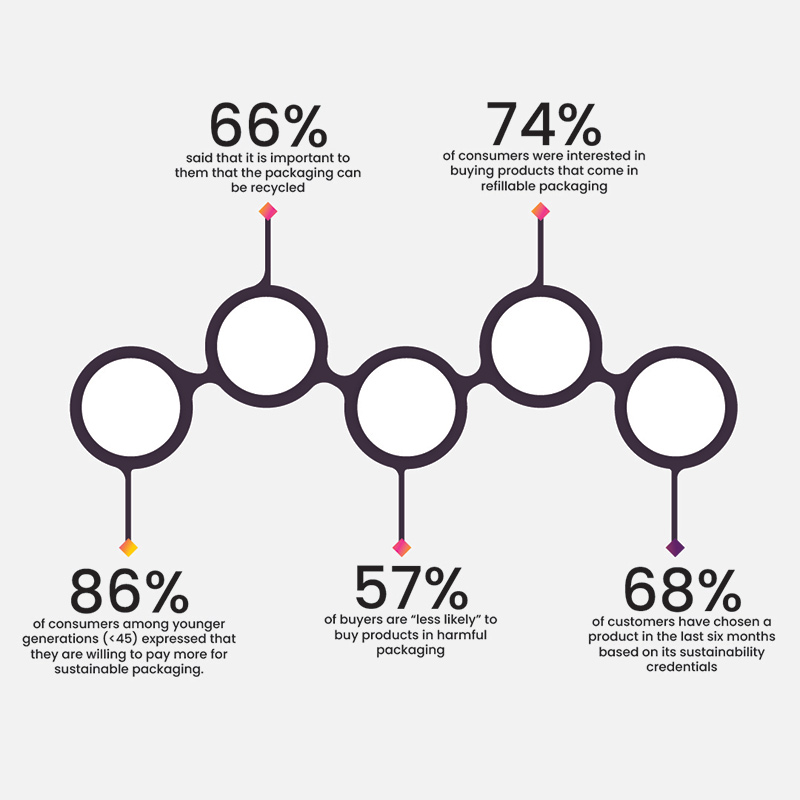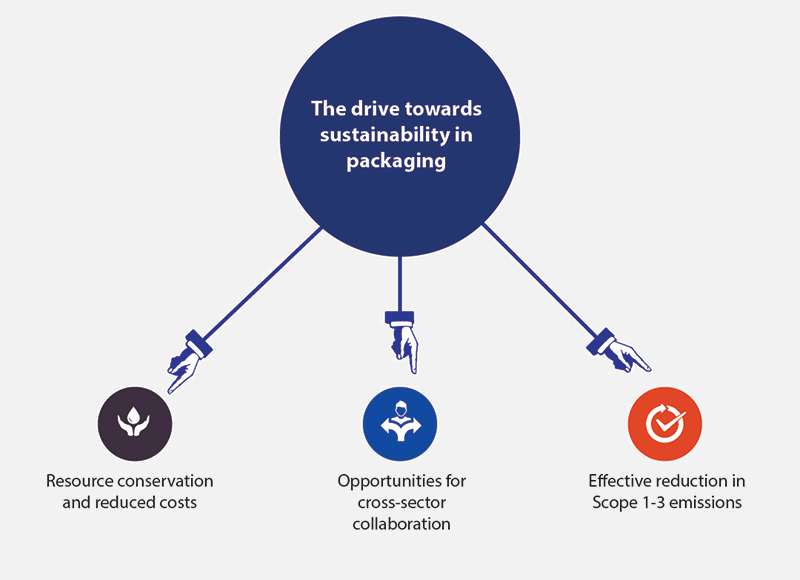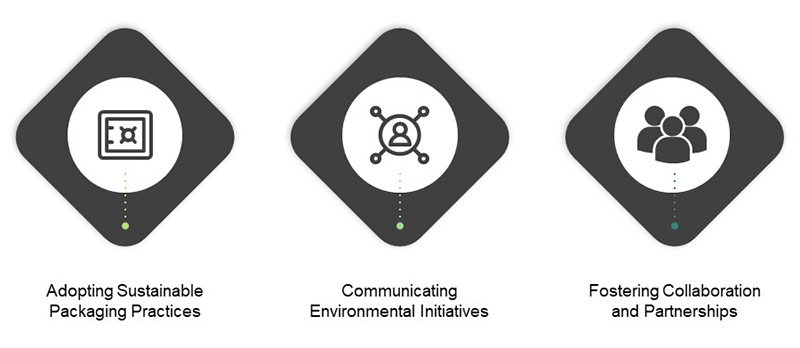Overview
Packaging with the most negligible negative environmental impact is said to be sustainable. In other words, environmentally friendly packing materials produce the least pollution during the manufacture, production, transportation, disposal, and recycling processes.

The increasing trend of spending on eco-friendly products and its impact on the scope of sustainable packaging. As consumer awareness and concern about environmental sustainability continue to rise, individuals are becoming more inclined to choose products that align with their values. This shift in consumer behavior has led to a surge in demand for eco-friendly alternatives across various industries, including packaging. Sustainable packaging plays a vital role in reducing waste, minimizing carbon emissions, and conserving natural resources. By analyzing the drivers behind the rising spending on eco-friendly products, this paper explores the opportunities and challenges associated with sustainable packaging and provides recommendations for businesses looking to capitalize on this growing market.
Market Demand
As of January 2023, consumers demanding sustainable packaging have risen to 81%, another massive jump towards eliminating plastic waste.
The Sustainable Packaging Market, worth around USD 265.9 billion in 2021, is estimated to grow to about USD 358.3 billion by 2028, with a compound annual growth rate (CAGR) of approximately 5.10% over the forecast period.
Reasons behind the Increasing Demand for Sustainable Packaging
With the rising pressure of climate change and its effects on the planet and 'consumers' demand for green packaging, the fame of sustainable packaging is shooting up.
- 86% of consumers among younger generations (<45) expressed that they are willing to pay more for sustainable packaging
- 66% said that it is important to them that the packaging can be recycled
- 57% of buyers are "less likely" to buy products in harmful packaging
- 74% of consumers were interested in buying products that come in refillable packaging
- 68% of customers have chosen a product in the last six months based on its sustainability credentials
So it is clear that the shifting consumer preferences have significantly influenced packaging trends - among which sustainable packaging is the hot favorite.
To get more insights on global eco-friendly packaging market, visit the website: https://www.databridgemarketresearch.com/reports/global-eco-friendly-packaging-market
The Drive towards Sustainability in Packaging
For manufacturers, meeting the increased demand for sustainable packaging is crucial to long-term business success.
Over half (52%) of consumers in the US and UK want brands to create products with less packaging, or at least recycled packaging. In Asia, consumers in China, India and Indonesia – arguably three of the largest markets in the region – feel very strongly about sustainability and are willing to put their money where their mouth is. Whether 'you're a packaging manufacturer, a manufacturer who produces their own packaging in-house, or a manufacturer who purchases their packaging from third-party suppliers, here are three ways that choosing eco-packaging can open up new opportunities for your business.
Data Bridge Market Research analyses that the sustainable packaging market will project a CAGR of 6.50% for the forecast period of 2022-2029. Rising focus on the packaging product innovations and technological advancements by the manufacturers, growth and expansion of packaging industry especially in the developing economies such as India and China are the factors driving the growth of sustainable packaging market.

Resource Conservation and Reduced Costs
A key component in plastics is fossil fuels, which have seen soaring prices in recent years. In addition, plastics are not just used in packaging material, but printing inks and adhesives as well.
More eco-friendly options such as recycled cardboard, sugar cane pulp or bamboo paper, corn starch-derived plastics, gelatine glue, and more are less costly and energy-intensive than conventional plastics and styrofoam. Their manufacturing processes also release fewer environmental pollutants and carbon emissions.
Beyond changing packaging materials, manufacturers can also look at streamlining their packaging designs to reduce the amount of unused or wasted space. Additionally, smaller packages contribute to reduced shipping costs.
Opportunities for Cross-Sector Collaboration
Circularity is one of the core pillars of eco-packaging. Some of the above-mentioned packaging materials tend to be by-products of certain industries, opening up opportunities for cross-sector collaboration. Bagasse paper, for instance, is made from sugar cane pulp, which packaging manufacturers can obtain at low cost from the sugar industry.
Product manufacturers can also partner with recycling companies to promote more sustainable disposal of their packaging. Two of a 'Kind's Project 2×2, for example, collects and recycles contact lens blisters for reduced pollution in landfills and to promote better circularity of plastics.
Effective reduction in Scope 1-3 emissions
'It's not just consumers that are demanding better sustainability. Investors, financiers and broader stakeholders, too, are increasingly scrutinizing ESG metrics for manufacturers, with regulators even stepping in to ban or limit the import of single-use plastics and incentivize recyclable packaging.
Eco-packaging can significantly reduce Scope 1-3 emissions in manufacturing, regardless of whether you produce your own packaging or purchase them from a third party.
Business Strategies
Adopting Sustainable Packaging Practices
This strategy emphasizes the importance of businesses prioritizing adopting sustainable packaging practices. It encourages companies to source eco-friendly materials, implement waste reduction strategies, optimize package design, and explore alternative packaging options such as recyclable or compostable materials. By incorporating sustainable packaging practices into their operations, businesses can minimize their environmental impact, meet the increasing consumer demand for eco-friendly products, and gain a competitive advantage in the market.
Communicating Environmental Initiatives
This strategy focuses on effectively communicating a company's environmental initiatives and sustainable packaging efforts. It highlights the need for businesses to convey their commitment to sustainability transparently. This can be achieved through clear labeling and packaging information that highlights eco-friendly features, engaging in sustainability-focused marketing campaigns, and utilizing digital platforms and social media to share their environmental initiatives with consumers. Transparently communicating sustainability efforts builds trust, enhances brand reputation, and attracts environmentally conscious consumers who are actively seeking eco-friendly products.
Fostering Collaboration and Partnerships
This strategy emphasizes the importance of collaboration and partnerships for driving sustainable packaging practices. It suggests that businesses should actively seek opportunities to collaborate with suppliers, packaging manufacturers, and industry experts. By working together, companies can explore innovative solutions, share best practices, and leverage collective knowledge and resources. Collaborating with other companies in the value chain can lead to the development of new sustainable packaging materials, technologies, and designs. By fostering collaboration and partnerships, businesses can accelerate their sustainability efforts and contribute to the overall advancement of sustainable packaging practices industry-wide.
Key Principles and Characteristics of Sustainable Packaging
- Source Reduction: It focuses on reducing the amount of packaging material used without compromising product safety or integrity. This can be achieved through light-weighting, optimizing package design, and eliminating unnecessary packaging components.
- Recycling and Reusability: Sustainable packaging is designed to be easily recyclable, ensuring that materials can be efficiently processed and reused to produce new packaging or other products. It also promotes the use of reusable packaging systems that reduce waste and resource consumption.
- Biodegradability and Composability: Packaging materials that are biodegradable or compostable can break down naturally in the environment, reducing the accumulation of waste in landfills. These materials can be safely returned to the soil as nutrients, contributing to a more sustainable waste management system.
- Energy and Carbon Efficiency: Sustainable packaging aims to minimize energy consumption and carbon emissions associated with the manufacturing, transportation, and disposal of packaging materials. This can be achieved through energy-efficient production processes, utilizing renewable energy sources, and optimizing transportation logistics.
- Life Cycle Assessment (LCA): LCA is a methodology used to evaluate the environmental impact of packaging throughout its entire lifecycle, from raw material extraction to disposal. Sustainable packaging considers LCA findings to identify improvement areas and implement more environmentally friendly practices.
- Consumer Education: Sustainable packaging often includes clear and accurate labeling to inform consumers about proper disposal methods, recycling instructions, and the environmental benefits of choosing eco-friendly packaging options. This education encourages responsible consumer behavior and promotes the adoption of sustainable practices.
Shift Towards Eco-Friendly Products

- Environmental Awareness and Concerns: Heightened environmental awareness has significantly driven the consumer shift towards eco-friendly products. Increased media coverage, education, and access to information have raised awareness about environmental issues such as climate change, pollution, deforestation, and resource depletion. Consumers are more conscious of their purchasing decisions' impact on the planet and seek products that minimize environmental harm
- Influence of Millennials and Gen Z: Younger generations, particularly millennials and Gen Z, have driven the demand for eco-friendly products. These demographics strongly emphasize sustainability, social responsibility, and ethical practices. They actively seek out products and brands that align with their values and prioritize environmental sustainability. Their collective purchasing power and influence have propelled sustainable products into the mainstream
- Regulatory Factors: Government regulations and policies have also contributed to shifting consumers towards eco-friendly products. Many countries have implemented environmental regulations and standards that incentivize or enforce sustainable practices. These regulations can include product labeling requirements, restrictions on certain materials, and incentives for businesses that adopt sustainable practices. Regulatory measures create a supportive framework that encourages businesses to offer eco-friendly alternatives and consumers to choose them
- Increased Product Availability: The availability and accessibility of eco-friendly products have increased dramatically in recent years. Businesses have recognized the growing consumer demand by developing and offering a wider range of sustainable options. Eco-friendly products are now more readily available across various industries, including food and beverages, personal care, fashion, and household goods. This increased availability makes it easier for consumers to choose eco-friendly alternatives
- Health and Wellness Considerations: Consumers are becoming more conscious of the potential health and wellness implications of conventional products and packaging. There is a growing demand for products that are free from harmful chemicals, allergens, and toxins. Eco-friendly products often align with these health-conscious preferences, as they tend to be formulated with natural ingredients and avoid harmful additives. This aspect further drives the consumer shift towards eco-friendly alternatives
Market Opportunities and Challenges
- Growing Demand for Sustainable Packaging
There is a significant market opportunity for sustainable packaging due to the increasing demand from consumers who prioritize eco-friendly products. As environmental awareness and concerns continue rising, more individuals actively seek products with sustainable packaging options. This demand extends across various industries, including food and beverages, personal care, household goods, and e-commerce. Businesses that can provide innovative and effective sustainable packaging solutions have the opportunity to capture a larger market share and gain a competitive advantage.
- Supply Chain Considerations
Implementing sustainable packaging practices requires careful consideration of the entire supply chain. Sourcing sustainable materials, such as recycled content or biodegradable alternatives, can present challenges in terms of availability, cost, and quality. Additionally, ensuring the efficient and environmentally responsible transportation of materials and finished products is essential. Collaboration with suppliers, logistics providers, and packaging manufacturers is crucial to address these challenges and create a sustainable supply chain.
One of the key challenges businesses face when adopting sustainable packaging is the potential cost implications. Sustainable packaging materials and design may initially be more expensive than conventional options. However, as demand increases and economies of scale come into play, the cost gap is expected to narrow. It is important for businesses to carefully evaluate the long-term cost benefits and potential savings associated with sustainable packaging, such as reduced waste disposal costs and enhanced brand reputation.
- Innovation and Collaboration:
To fully capitalize on the market opportunities presented by sustainable packaging, businesses need to foster a culture of innovation and collaboration. Developing new packaging materials, technologies, and design solutions that meet both environmental and functional requirements is essential. Collaboration with industry partners, research institutions, and packaging experts can help drive innovation and address complex sustainability challenges. Sharing best practices, knowledge, and resources can benefit the industry as a whole and expedite the adoption of sustainable packaging solutions.
- Consumer Education and Communication:
Effective communication and education about the environmental benefits of sustainable packaging are crucial for businesses to capture consumer interest and loyalty. Transparent and clear labeling can help consumers make informed choices and understand the proper disposal or recycling methods for sustainable packaging. Businesses should invest in consumer education campaigns and engage with customers to raise awareness about the environmental impact of packaging and the benefits of choosing eco-friendly options. Building trust and credibility through transparent communication is essential to capture the growing market of environmentally conscious consumers.
The Role of Sustainable Packaging

Sustainable packaging plays a crucial role in promoting environmental sustainability and addressing the negative impacts of conventional packaging practices. It encompasses the use of materials, design principles, and manufacturing processes that minimize harm to the environment throughout the lifecycle of a package. Here are the key aspects that highlight the role of sustainable packaging:
- Waste Reduction: Sustainable packaging aims to minimize waste generation throughout the packaging lifecycle. This includes reducing packaging material usage through source reduction strategies, optimizing package design to eliminate unnecessary components, and promoting the use of reusable or refillable packaging options. By minimizing waste, sustainable packaging helps conserve resources and reduces the burden on landfills and waste management systems
- Carbon Emission Reduction: Sustainable packaging seeks to minimize the carbon footprint associated with packaging materials and processes. This involves using materials with lower carbon emissions, such as recycled or bio-based materials, and adopting energy-efficient manufacturing techniques. By reducing carbon emissions, sustainable packaging contributes to mitigating climate change and promoting a more sustainable and low-carbon economy
- Resource Conservation: Sustainable packaging promotes the efficient use of natural resources by prioritizing renewable, recyclable, or compostable materials. It encourages the use of recycled content in packaging materials, reducing the need for virgin resources. Additionally, sustainable packaging considers the responsible sourcing of materials to minimize the negative impact on ecosystems and biodiversity. By conserving resources, sustainable packaging helps preserve natural habitats and supports the long-term availability of resources
- Circular Economy: Sustainable packaging aligns with the principles of a circular economy, aiming to keep materials in use for as long as possible and minimize waste generation. It emphasizes the design of easily recyclable or compostable packaging, enabling the materials to be effectively recovered and reused in the production of new packaging or other products. By promoting a circular economy, sustainable packaging reduces reliance on finite resources and contributes to a more sustainable and regenerative system
- Consumer Perception and Preference: Sustainable packaging significantly influences consumer perception and purchasing decisions. As environmental awareness and concerns continue to rise, consumers are actively seeking products packaged in an environmentally responsible manner. Sustainable packaging communicates a brand's commitment to environmental sustainability, enhancing brand reputation and attracting ecologically conscious consumers. Sustainable packaging drives consumer loyalty and market competitiveness by meeting consumer preferences for eco-friendly options
- Regulatory Compliance: The role of sustainable packaging is also influenced by regulatory frameworks and policies that promote environmental sustainability. Many governments and regulatory bodies have implemented regulations and standards related to packaging waste, recycling, and environmental impact. Sustainable packaging helps businesses comply with these regulations and demonstrates their commitment to environmental stewardship.






